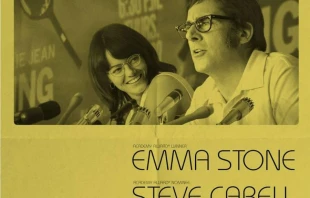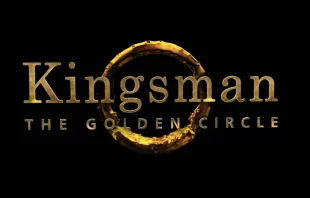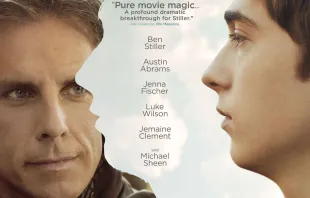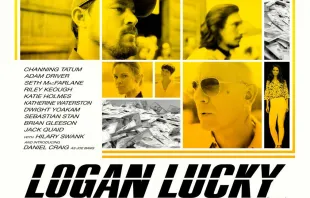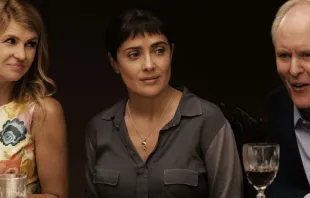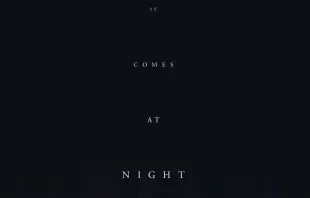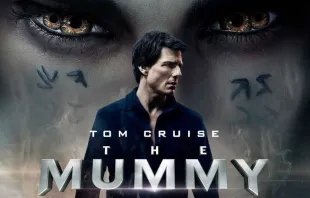Articles by Carl Kozlowski
Movie Review: “Lady Bird”
Dec 1, 2017 / 00:00 amI’ve always been fascinated to see what happens when a prominent actor or actress decides to take a seat behind the camera and make a truly personal artistic statement. From the stunningly dark visuals and spirit of Charles Laughton’s 1955 moody masterpiece “Night of the Hunter” to Clint Eastwood’s moody 1971 thriller “Play Misty for Me,” on down through Tom Hanks’ 1996 showbiz dramedy “That Thing You Do!” and Jason Bateman’s 2013 comedy “Bad Words,” a solid directorial debut offers intriguing insights into their creative process and true passions. Yet even among these acclaimed and often beloved films, few stand out as more self-assured and personal than indie goddess Greta Gerwig’s current writing-directing debut, “Lady Bird.” Coming off a string of acclaimed cult comedies in which she delivered a series of performances that were giddy, goofy and earnest all at once, it would have been easy to assume that any creation of Gerwig would be a lightweight soufflé. Surprisingly, her debut film, “Lady Bird,” while seemingly just another coming-of-age story set against a backdrop of 1980s rock and pop music, achieves some serious emotional resonance. Depicting the senior year of a gawky yet cute teenage girl in 1983 Sacramento who calls herself “Lady Bird,” the movie provides a wise and affecting look at teenagers trying to figure their place in the world. It’s also a powerful portrait of the bond between mothers and daughters and – even rarer – a respectful homage to small-town life and the close emotional connections it can bring. The movie offers a slice-of-life look at a girl named Christine (Saiorse Ronan) who has renamed herself “Lady Bird” in order to stand out from the crowd both at home and at school. Feeling trapped in nondescript Sacramento, she dreams of fleeing to a college on the East Coast where she can pursue a drama degree and never look back. But Lady Bird has a few basic problems. First, she doesn’t have the grades to achieve an Ivy League education; second, her plain-Jane and depressed yet caring mom (Laurie Metcalf) feels that any choice that takes Lady Bird out of the area is a deep rejection of her and all that she’s done for the girl. And third, the financially struggling family is hard-pressed to afford any type of college, much less the most elite ones around. Yet Lady Bird still does her best to walk the line between relatively mild rebellion and being a straight arrow. Along the way, she has to navigate one close teenager’s life in the closet, whether to trust another boy enough to be her first sexual experience, and figure out how far to let her freak flag fly. These are universally touching matters, ones that nearly everyone faces at some point in their life while growing up in America. Gerwig, however, does a remarkable job of making these eminently relatable and often funny moments resonate with everyone even as much of its beauty and humor are rooted in the odd details of life in Catholic schools. Gerwig does a remarkable job portraying a Catholic teenager torn between the "good girl" everyone expects her to be, and her growing desires to be different. The movie handles the complex emotions of teen romance and, yes, sex with discretion visually and powerful emotion. Its portrayal of the priests and nuns in her life are all uniformly positive, Lady Bird's relationship with her mother may be occasionally contentious, but it also is one of the most positive portrayals of a teenage child/parent relationship in ages. The relationship between Lady Bird and her mother is one for the ages, beautifully drawn and wonderfully portrayed by Ronan and Metcalf. Both are likely to be nominated for Oscars this coming spring, along with the stellar writing and directing talents of Gerwig. This is the breakout art house hit of the year. I urge you strongly to go and see why.
'The Florida Project'
Oct 13, 2017 / 00:00 amIt’s almost impossible to find a truly fresh take on American life after more than a century of cinema, but filmmaker Sean Baker has managed with his third film to again present slices of life from the underbelly of society that are often if not completely overlooked. After his 2012 debut “Starlet” and 2015 follow-up “Tangerine,” Baker's latest, “The Florida Project,” builds on his ultra-realistic, cinema verite approach while taking the action out of Los Angeles and into a somewhat more innocent terrain, following a group of poor children through a long and lazy summer while they’re stuck living with their largely irresponsible parents in a cheap motel in Orlando. Baker pulls off a remarkable feat here, as the minimal plot seems to richochet among random incidents, yet builds to an emotionally resonant ending that will be hard for viewers to shake. “Florida” largely centers on a trio of 7-year-old kids led by a girl named Moonee who engage in mischievous activities such as spitting on cars from the balcony of their motel and panhandling change to buy ice cream cones. The kids have foul mouths often played for laughs, developing their bad behavior by having almost no supervision from their parents. Moonee’s mom is a stripper with tattoos (a job only briefly discussed, and not shown) and a bad green dye job in her hair, and the other parents are barely more respectable. The one true authority figure in the entire film is the motel manager Bobby, played by Willem Dafoe as a kindhearted middle-aged man who wants the best for his tenants but is always just one step ahead of complete anarchy breaking out in the complex. The childhood mecca of Disney World is in the same city, just miles away, but these children may as well be living on the other side of the planet. Dafoe is the one recognizable actor in the cast, building on Baker’s tendency to hire complete unknowns in the interest of immersing viewers in his characters’ lives. It’s a beautiful performance that combines world-weary exasperation with genuine concern for the kids, which most clearly emerges when he has to handle a creepy old man who appears on the property and shows too much interest in the young residents. Bobby is also the key to leading viewers into the deeper point of “Florida”: showing the lives of people teetering on the edge of homelessness as they hustle to pay the weekly rent on a motel room. Moonee’s mom not only strips (that job is discussed, not shown), but also buys cheap perfume wholesale and shakes down tourists to buy bottles at a profit. Always a day late in paying the rent, she tries to charm Bobby into greater understanding, but eventually true reckoning is heading her way. “Florida” was a sensation at this year’s Sundance Film Festival, both for Baker’s ability to draw vibrant performances from totally unknown children and young adults, and for shining a light on the silent American epidemic of people who are living one wrong step away from homelessness. While nearly everyone knows someone who lives paycheck to paycheck, “Florida” reveals what it’s like to survive without an actual paycheck at all. The seemingly meandering pace of “Florida” makes this a film that the masses will overlook, but those who can handle arthouse movies and give it a chance will be richly rewarded with a new viewpoint on life and an appreciation for what they have. It’s an arthouse movie playing in only a few cities right now, but spreading nationwide in the coming weeks. If you want something different, it’s definitely worth a try for adults.
'The Stray' inspired by director's real-life turnaround
Oct 3, 2017 / 13:18 pmMitch Davis had the best intentions for his career and family life. He was an executive at the Disney and Columbia movie studios in the 1980s. He wanted to make family films, and he made the effort to be home around his kids, while many Hollywood colleagues logged countless extra hours at their offices.
Movie review: “Battle of the Sexes”
Sep 23, 2017 / 00:00 amThe new movie “Battle of the Sexes” focuses on the famous 1972 showdown between women’s tennis champ Billie Jean King and former mens’ tennis champion Bobby Riggs. It’s a zippy and entertaining slice of history that features great performances by Emma Stone and Steve Carell, but it also carries some major baggage for Catholic viewers due to its depiction of King’s off-court battles with her sexual orientation. “Battle” leads off with Billie Jean King (Stone) shown as the unstoppable womens’ tennis champion of the world. However, she and her attorney Gladys Heldman (Silverman) are mad that she is paid far less than the male champions and challenge the pro tennis association leaders to pay equally. When they laugh, King breaks off and forms her own women’s tennis association. Throughout, the issue of whether she’s a feminist comes up, and King replies her concern is almost solely on equal financial treatment for women athletes. As she nears her women’s association announcement, she meets a hairstylist named Marilyn (Riseborough), who is very seductive as she cuts King’s hair in an extended, sensuously filmed sequence. Soon, Marilyn is invited on the tour as the women’s hairstylist since they rely on media appearances, and King and Marilyn begin a lesbian affair. The make out scenes are surprisingly intense for a PG-13 movie, stronger than most straight couples are portrayed in such situations, and they are shown embarking on this flirtatiously and happily at first. However, King is torn about the effect on her husband since her feelings have been closeted within a straight marriage. When her husband Larry (Austin Stowell) finds out, he is torn between his emotional devastation and his wish to help her succeed in her cause above all else. Meanwhile, former mens’ tennis champ Bobby Riggs (Carell), who is 55 while King is 29, challenges a female champ to play him for a large monetary prize in the hopes of showing that males are superior and colorfully rebuke the burgeoning feminist movement. When he defeats one female champ, he challenges King for a $100,000 winner take all prize that she can’t refuse after turning him down for the initial match. Riggs’ inveterate and humorously portrayed gambling addiction impacts his marriage, and he is contrasted training humorously with King’s serious efforts. Their clashing styles capture the nation’s attention and make for an entertaining series of confrontations. “Battle” is portraying the real-life affair that King engaged in at the time, but it places a strongly positive viewpoint on the lesbian relationship overall. It impressively adds depth by showing the emotional damage wrought on Larry and the way that Riggs’ gambling affects his own life, and there are some positive elements of forgiveness shown by Larry and reconciliation shown in Riggs’ marriage. Stone delivers a richly layered performance, mixing strong determination for her cause with her emotional confusion in her personal life while also displaying occasionally strong wit in bantering with Riggs. Carell has a distinctly smaller role for the first half, and brings a healthy dose of colorful humor to the movie before showing an impressive emotional depth as events turn against Riggs later. Aside from the movie’s focus on the lesbian relationship, this is a very entertaining movie, and it’s a shame that the filmmakers did not choose to focus on the tennis matches and battle of principles more than the affair. There is definitely a lot to talk about here regarding relationships and marriage, though, and that’s more than most movies offer couples these days. Overall, “Battle” is an extremely well-made movie artistically and its agenda will likely help it become a contender for critics’ honors and the Oscars at the end of the year. But its extremely positive portrayal of homosexuality detracts from its strengths for Catholic viewers, and anyone who sees it should take note that its foreplay scenes are very intense for the rating.
Movie review: “The Kingsman: The Golden Circle”
Sep 22, 2017 / 00:00 amThe idea that “bigger is better” is one that Hollywood often applies to its sequels, upping the explosions, effects, body counts and stunt casting of its action-hit follow-ups rather than attempting to create fresh stories and genuine creativity. This weekend’s new “Kingsman: The Golden Circle” is another example of that thinking, with its trailers proclaiming the additions of stars Channing Tatum, Julianne Moore, Jeff Bridges and Halle Berry to the cast of this sequel to 2015’s surprise spy movie hit “Kingsman: The Secret Service.” Unfortunately, while such big talents should have taken this to a higher level, they’re all underused in another example of Hollywood hype. The fantastic first “Kingsman” set up the adventures of Gary “Eggsy” Unwin (Taron Egerton), a 17-year-old Briton who was recruited to join a secret society of spies called Kingsman by agent Harry Hart (Colin Firth), who was code-named Galahad. The movie followed Eggsy through an inventive and action-packed series of training exercises before he teamed up with Galahad to combat an evil cellphone mogul (Samuel L. Jackson) who concocted a fiendishly evil plan to kill off millions in the hopes of stemming global warming. “Secret” brought an impressive flair to its action sequences, thanks to director Matthew Vaughn, who had honed a unique style that blended humor with hyper-violence in the two “Kick-Ass” superhero movies. The combination of Firth’s middle-aged cool with Egerton’s manically youthful energy played superbly off of Jackson, who seemed to enjoy his role more than any he had in a decade. Vaughn is back at the helm of “Circle,” co-writing again with Jane Goldman, and kicks things off impressively with Eggsy forced to fend off an attempted kidnapping by his enemy Charlie (Edward Holcroft) in an utterly insane car chase/battle royale. Charlie had been rejected by Kingsman and appeared to be killed off in the first film, but it turns out he survived with only the need for a new robotic arm to replace the one that was lopped off. While Eggsy escapes the attack, Charlie’s robotic arm manages to access Eggsy’s secret Kingsman login, and soon the agency’s secret headquarters and nine other prime targets are decimated by missiles. A series of clues spurs Eggsy and sidekick Merlin (Mark Strong) to head to Kentucky, where they discover a parallel American agency called Statesman that’s hidden inside a whiskey distillery. The two initially wind up teaming with Statesman Agent Tequila (Tatum) to take on a villain named Poppy (Moore), who is attempting to consolidate and dominate the entire planet’s illegal drug trade under her cartel, named the Golden Circle. Eggsy and Merlin also have to contend with the shocking discovery that Harry is alive and being held by the Statesman agents after he appeared to be killed in the first film. The problem is, Harry has severe amnesia and the attempts to revive his memory have gone very wrong. As they drag him into their attempt to save the planet from Poppy, Harry may prove to be as much of a liability as an asset. Much of the fun in the first “Kingsman” came from its training sequences, as Eggsy was subjected to a vast array of highly dangerous tests en route to joining the agency. Since he’s not in need of training anymore, “Circle” suffers from the fact that a large part of its middle section has no big action sequences at all, leaving much of the mayhem to the first and last half-hours of its 141-minute running time. Moore stays mired throughout in Poppy’s remote lair, cackling up a storm but never doing much other than ordering Charlie – who became her right-hand man after his Kingsman rejection – and her other minions around. Tatum starts out having a blast as Agent Tequila, but is soon incapacitated for much of the movie while Bridges, who plays the head of the Statesman agents, also has hardly anything to do. Berry is basically reduced to Miss Moneypenny-style status, supporting the Statesmen at their base, albeit with a sweetly whimsical charm. On the plus side, “Circle” features a funny extended celebrity cameo I won’t give away, with a veteran English superstar poking a surprising amount of fun at himself. There’s also a rollicking sequence involving Eggsy and Merlin fleeing an attack onboard an out-control-funicular in the Italian Alps. Regarding content, “Circle” features a rather large amount of profanity, with about 50 F-words and some other random language throughout. In the context of its action-comedy tone, it’s not particularly shocking, however. The most potentially offensive element is a sequence in which Eggsy has to implant a tracking device with Charlie’s girlfriend. It is a rather raunchy sequence but brief in the overall spectrum of the film – if you have seen the first film or others in this genre and took risqué humor in stride, you’ll handle this. But if you’re easily offended, take note: it doesn’t involve nudity but is nonetheless pretty extreme. One plus is that “Circle” doesn’t feature any scenes that are sacrilegious or anti-Christian. The first film’s biggest flaw was a controversial, highly violent scene in which an entire fundamentalist church’s congregation was shot to pieces after a rant by a conservative preacher. The final battles devolve into a bunch of hyperactive shootings and explosions that largely lack the wicked charm of the first “Kingsman” movie. But this is still better than most of the action flicks the major studios have released this year and fun enough for those who are fans of the first film and the spy genre, even if unfortunately it’s not quite golden.
Movie review - "Brad's Status"
Sep 15, 2017 / 00:00 amIt’s easy to overlook counting our blessings, and the new movie “Brad’s Status” tries to provide a thoughtful and occasionally funny reminder of that unfortunate fact. It stars Ben Stiller as Brad, a 47-year-old husband and father who is wallowing in a mid-life crisis while taking his teenage son on a weekend college scouting trip that includes his own alma mater, Tufts University. The fact he’s returning to his old stomping grounds leads Brad to reminisce and obsess on his life choices in comparison to his more successful old college buddies. Yet he’s overlooking the fact that he has a pretty good life going for himself. Written and directed by Mike White, who has previously written several movies with fresh points of view including “School of Rock,” “Nacho Libre” and “The Good Girl,” the film places the focus largely on Stiller and his interior monologues complaining about his average life. That’s not necessarily a good decision, since Brad and the old friends he obsesses about are so miserable and annoying that few viewers will want to spend any time with them. Brad is first seen tossing and turning in his sleep, asking himself how his life turned out the way it has before asking his wife Melanie (Jenna Fischer) if they are likely to inherit her wealthy parents’ expensive home in the hopes that it would be their backup plan for a cushy retirement. Brad heads his own non-profit while Melanie has a secure government job, giving them a solid upper-middle-class life, but he’s obsessed with the fact that several of his college friends have gone on to vast success in high-profile industries. Jason (Luke Wilson) is head of a hedge fund, while Billy (Jemaine Clement) has sold his tech company and retired to a life of drug-taking and living with two women on an island, and Nick (Mike White, who also wrote and directed the movie) is a hotshot filmmaker who’s gay and throwing pool parties for lots of young men en route to getting married. While those three are mostly seen in Brad’s jealous imaginings, he forces a reunion with Craig (Michael Sheen), who has become a prominent TV pundit and author and has the connections to help Troy get special attention at Harvard. The tension behind that meeting and Brad’s encounters with Troy’s young idealistic friends force him into some serious reckonings about the state of his own life. “Status” revolves so much around Brad’s impressions and ideas of what his old friends’ lives are like that viewers are shown almost nothing of their actual realities. This could be White’s way of showing how clueless Brad himself is about their lives, but the fact that Brad barely connects with any of them other than Craig gives the audience little to care about. Stiller does a solid job as Brad, conveying the well of emotions that are bottled up inside of him, but his incessant whining is largely unappealing. Abrams as Troy has the most genuine interactions with Brad, but he’s not called upon to show much range other than being a nice kid who is increasingly worried by his dad’s obvious sadness. When Stiller is able to cut loose a little and put some comic energy into his complaints while trying to get an airline seating upgrade or convince Harvard officials to bend their rules a little, “Status” shows some sparks of life. But such moments are too few and far between. On the plus side, “Status” does have some affecting moments, since nearly everyone has at some point questioned their life choices, and it does show Brad to be a loving husband and father, which is all too rare in movies these days. White uses discretion in depicting Billy and Nick’s hedonistic lifestyles, with both largely implied rather than graphically shown, and there’s some casual but not overbearing use of the F word scattered throughout the film. “Brad’s Status” opens in a few major cities this weekend before opening more widely Sept. 22.
Fall Movie Synopsis
Sep 1, 2017 / 00:00 amThis weekend marks the first time in more than 20 years that Hollywood has completely thrown in the towel and not bothered to release a major movie over Labor Day weekend. So instead, I’m looking ahead to some of the most intriguing movies coming out during the next three months. We'll see whether they hold up to artistic and moral scrutiny over the coming weeks. “It” (Sept. 8) One of horror master Stephen King’s most popular novels – about a group of bullied kids in small-town Maine who team up to take on an evil clown named Pennywise, who’s been killing children for centuries – finally hits the big screen more than 30 years after it was published. Early word is that this is an absolutely terrifying adaptation, though the book’s 1,138-page length means that viewers will have to wait a couple of years to see the actual conclusion, since the filmmakers have split the story into two films. “Mother!” (Sept. 15) Jennifer Lawrence and Javier Bardem play a happily married couple who find that their tranquil life is turned upside down by the arrival of a creepy, uninvited couple played by Ed Harris and Michelle Pfeiffer. All four leads have been Oscar winners or nominees, a remarkable casting coup that could make this the acting showdown of the year under the creative hand of writer-director Darren Aronofsky (“Black Swan”). “The Kingsman: The Golden Circle” (Sept. 22) Director Matthew Vaughn brought daringly funny new life to the British spy genre with “The Kingsman: The Secret Service,” and this time he has nerd-turned-super-agent Gary “Eggsy” Unwin (Taron Egerton) teaming up with an American secret society against an even greater world threat. Adding Jeff Bridges and Channing Tatum to the mix seems a recipe for an even tastier mix of action and comedy. “Battle of the Sexes” (Sept. 22) Emma Stone follows her Oscar-winning turn in “La La Land” by playing tennis legend Billie Jean King in the true-life story of King’s 1973 on-court showdown with former champ and perpetual hustler Bobby Riggs (Steve Carell). Directors Valerie Faris and Jonathan Dayton worked wonders with the Best Picture-nominated dramedy “Little Miss Sunshine,” leaving high hopes that this comical take on history will score an ace. “American Made” (Sept. 29) Tom Cruise finally appears to be stretching his talents again after five “Mission: Impossible” movies, the wretched reboot of “The Mummy” and a string of middling sci-fi films. Here, he’s taking on the role of real-life former airline pilot Barry Seal, who became a drug smuggler for the Medellin Cartel in the 1980s before becoming a DEA informant to avoid jail time while nearly bringing down the Reagan White House. “Blade Runner 2049” (Oct. 6) Harrison Ford continues his late-career renaissance by finally making a sequel to the sci-fi classic he made outside the “Star Wars” series. Ryan Gosling plays a new blade runner for the Los Angeles police who embarks on a quest to find Ford’s Rick Deckard, who’s been missing for 30 years, after discovering a secret that could ruin society. Original director Ridley Scott is only onboard as an executive producer here, but the film appears in good hands with director Denis Villeneuve, who proved he has the ability to craft stellar sci-fi with last year’s Best Picture nominee “Arrival.” “Marshall” (Oct. 13) Chadwick Boseman delivered strong performances as Jackie Robinson in “42” and James Brown in “Get On Up,” and he attempts a trifecta of winning portrayals of African-American icons with this film about a key case in Thurgood Marshall’s career prior to becoming the first black justice on the US Supreme Court. “Suburbicon” (Oct. 27) The Coen brothers intended to make this darkly comic crime film even before their commercial breakthrough with 1987’s “Raising Arizona,” but it took their “Burn After Reading” star George Clooney as director to finally bring it to the big screen. Matt Damon plays a husband and father in 1959 suburbia who finds that his town’s idyllic surface is hiding a disturbing underbelly of secrets and violence. The trailer makes this look like an oddball winner. “Justice League” (Nov. 17) Until this year’s terrific “Wonder Woman,” the films based on DC Comics have always taken a more somber approach to its superhero movies than its archrivals at Marvel. It will be interesting to see how this film will compare with the pure pop fun of “The Avengers” films, as “League” brings all of DC’s biggest heroes together when Batman, Superman and Wonder Woman are joined by Aquaman and The Flash for this adventure. “Darkest Hour” (Nov. 22) This summer’s hugely successful “Dunkirk” has proven that today’s audiences will still line up for a serious WWII film, which bodes well for this biopic starring Gary Oldman as British Prime Minister Winston Churchill. This film follows Churchill as he faced the challenge of rallying England against the Nazis within days of taking office.
Double Review - “The Hitman's Bodyguard” and “Logan Lucky”
Aug 25, 2017 / 00:00 amThese are brutal times for movie lovers, with no new major releases coming until Sept. 8, when the long-awaited adaptation of Stephen King’s “It” finally reaches the big screen. Strangely, the last two major movies of summer could have played in theaters decades ago, with “The Hitman’s Bodyguard” badly imitating the buddy-cop formula used by countless action comedies in the 1980s. Thankfully, “Logan Lucky” adds fresh Coen Brothers-style twists to the kind of Southern-fried action comedies that Burt Reynolds starred in back in the 1970s. The result is a fun time, although its pacing veers oddly between drawn-out character moments and spirited and funny crime caper elements. “Bodyguard” brings together Ryan Reynolds and Samuel L. Jackson, two actors who have loads of charisma but whose resumes overflow with movies they seem to have made because their paychecks cleared. That certainly seems to be the case here. Reynolds plays Michael Bryce, who was a hotshot private-security bodyguard until one of his biggest clients was assassinated right before his eyes. Now disgraced and working only low-level assignments, he is roped in by an ex-girlfriend Interpol agent to transport professional assassin Darius Kincaid (Jackson) from England to the International Criminal Court in the Netherlands so he can testify in the genocide trial of a Belarusian dictator (Gary Oldman). The two have a long history of hating each other, with Kincaid having attempted to kill Bryce on multiple occasions as they crossed paths around the world. As they race to make it to the courtroom in time for the judges’ deadline, they dodge seemingly dozens of the dictator’s minions in an endless stream of over-the-top action sequences, trading insults all the while. “Bodyguard” is annoying nearly from start to finish, completely defying all sense of internal logic as their enemies manage to find them in every corner of Europe within five seconds of their arrival. Screenwriter Tom O’Connor also relies on flashbacks to explain nearly every aspect of the movie, patching plot holes on a constant basis that feels insulting to the viewer. Director Patrick Hughes, who last gave the world the utterly mediocre “The Expendables 3” (which killed that action series), has the action veer far too much in its tone. There are some ridiculous yet fun chases including Kincaid wreaking havoc in a speedboat through the canals of Amsterdam, but they’re mixed with overly nasty moments such as having Bryce tortured repeatedly with electroshocks. Jackson and Reynolds should be embarrassed, although Salma Hayek is even worse as Kincaid’s Venezuelan wife Sonia. In prison for serving as accomplice to one of Kincaid’s criminal adventures, she adds to the nearly incessant screaming of Jackson by constantly berating her captors in a performance that defines the word stereotype. “Bodyguard” is packed start to finish with tons of foul language, particularly a constant barrage of variations on the “F word,” as one might imagine anytime Samuel L. Jackson stars in an R-rated action movie. It’s also filled with tons of action, with quite a few bloody gunshot victims and the aforementioned electroshock sequence rendering this a movie that’s not likely one for the squeamish. Its biggest offense, though, is the fact that it just plain stinks. “Lucky” is a lot more fun, following the story of blue-collar West Virginia brothers who plan a heist at the Charlotte Motor Speedway after a string of bad luck befalls them both. Channing Tatum plays Jimmy Logan, who is unfairly laid off from a construction job at the speedway due to a past injury, while his brother Clyde (Adam Driver) is a bartender who lost an arm while serving in the Iraq war. Though they are decent, hard-working guys overall, Jimmy and Clyde have a history of committing mischief and getting into bar brawls. Jimmy hatches a plan to get revenge on the speedway by robbing its vault in the middle of a race day and lures in both Clyde and a motley crew of lowlifes – including ace safecracker Joe Bang (Daniel Craig) and his idiot brothers – into his plot. Since Joe is already incarcerated for another crime, Jimmy and Clyde also have to figure out how to get him out of prison fast enough to help with the robbery and get him back into his cell before the guards notice. That ingenious twist, combined with its well-defined characters and dialogue that cleverly walks the line between making the brothers simpleminded yet creative, makes “Lucky” stand out as one of the most original popcorn movies in a long while. The key to making this mostly work is director Steven Soderbergh, who mastered the heist-comedy genre by helming the “Oceans 11” trilogy. He again draws colorful performances out of an eclectic cast, with Craig particularly fun while shedding his suavely British, James Bond image to play a redneck whose idea of a treat is hard-boiled eggs from the prison vending machine. Perhaps the biggest surprise comes from the fact that Soderbergh and his cast make the brothers sympathetic, rather than merely treating them with condescension. Tatum and Driver portray Jimmy and Clyde with an underlying sense of dignity beneath the laughs, providing a sense of respect for Red Staters that is rarely seen from Hollywood. That’s something to root for in these divided times, along with the fact that with occasional mild swearing and innuendoes and a fun, non-brutal approach to its heist, this is a movie with nothing that should really cause moral offense to anyone in its PG-13 age range and above.
Movie Review: “Ingrid Goes West”
Aug 18, 2017 / 00:00 amSocial media addiction is a growing problem among Americans, and the new movie “Ingrid Goes West” offers a dark satire about that sad state of affairs. A woman who leads an utterly empty life by spending her days obsessively searching for “likes” and the new postings of those with a large number of followers, Ingrid could be any one of the millions constantly staring down at their smartphones rather than interacting with the world at large. Directed by Matt Spicer in his feature debut, “Ingrid” skillfully pulls off an extremely difficult balancing act. On the one hand, it’s about mostly awful people, none of whom viewers should want to root for. On the other, it is taking point-blank critical aim at their behavior in a way that is often funny in spite of itself – and switches gears effectively into some serious moments depicting these actions as mentally disturbed behavior. The movie kicks off with Ingrid (Aubrey Plaza) crashing a wedding reception and macing the bride in the eyes for not inviting her, an action that results in a quick trip to a mental hospital. The idea is to break her psychotic rage and her obsession with Instagram – because she only knew the bride by manipulating her way into her life after meeting her via the site, and never should have expected to be invited to the wedding in the first place. Ingrid quickly winds up in a mental hospital until she seems to resolve her social-media obsession. Yet upon her release, Ingrid finds another friend on Instagram: a woman named Taylor (Elizabeth Olsen) who is living a seemingly glamorous life in Los Angeles. Cashing in a $60,000 inheritance from her late mother, Ingrid abruptly moves to LA to stalk Taylor and worm her way into her life. She rents a house in Taylor’s Venice neighborhood from a too-trusting guy named Dan (O’Shea Jackson Jr.) and steals Taylor’s dog in order to meet her when she returns it. The two become fast friends, although Taylor is unaware that Ingrid is an entirely fake person. With Taylor herself living a false and vacuous existence in which her every move is photographed for Instagram since her “career” involves promoting products in her pictures, they are a seemingly perfect match. But as Taylor’s husband and sleazy brother start to wonder about Ingrid’s odd behavior and notice her stories don’t add up, she winds up roping the unwitting Dan into her schemes. Her determination to avoid being caught and to grow ever closer to Taylor and her fame escalates into a surprisingly violent turn of events and eventually some serious consequences. “Ingrid” centers on a woman who is clearly disturbed and engages in morally abhorrent behavior towards everyone around her. Pushy, deceptive and manipulative, she is the worst person in a circle of people whose lives are shallowly centered on the empty allure of fame, and living lazy lives in which the most positive character is constantly smoking marijuana. Over the course of the film, Ingrid uses cocaine with Taylor, hatches a kidnapping plot that goes extremely awry, and engages in seduction to get what she wants – and that’s just the half of it, with plenty of foul language also clouding it. As mentioned before, the film manages to create a unique tone in which much of this manages to be humorous yet critical on a secular artistic level, but when looking at things from a moral point of view, it’s unfortunately unacceptable. It’s a shame, since the topic of social-media addiction and how it’s affecting our ability to form healthy relationships is one that is worthy and definitely timely. But there is definitely a point in which the depiction of corrupt behavior can corrupt the viewer’s sense of moral reasoning as well, and “Ingrid” crosses it. Plaza shows genuine talent here, both for energetic comedy and in showing the broken person buried beneath the surface of Ingrid. Jackson shows a lot of charm, with a deeply rooted kindness under Dan’s surface as well, while Olsen is solid at portraying a vacuous person with a falsely glamorous life. “Ingrid Goes West” is trying to be a morality play for our extremely misguided times, but features so much immorality along the way to its conclusion that Catholics should probably head in another direction.
Movie Review: “Brigsby Bear”
Aug 11, 2017 / 00:00 amFor the past four seasons of “Saturday Night Live,” cast member Kyle Mooney has created a series of unique video shorts that have thrown comic curveballs at viewers with a decidedly twisted point of view. In his new film “Brigsby Bear,” Mooney takes on fanboy obsession with pop culture, creating a very odd and surprisingly touching look at a guy who is so hooked on a TV show that it becomes the center of his existence – only to learn that he is the only person who has ever seen it. Mooney plays James Pope, a 25-year-old man-child who spends his days obsessively watching and analyzing VHS tapes of a show called “Brigsby Bear Adventures,” a cross between old Saturday-morning kids’ sci-fi shows such as “Land of the Lost” and “Barney and Friends.” The show follows an animatronic talking bear named Brigsby, who saves the universe from an evil villain called the Sun Snatcher each week while teaching seemingly sweet but bizarre life lessons. James still lives with his parents in what appears to be their basement but is soon revealed to be part of an underground bunker in the Utah desert. His only view of the outside world comes when he climbs out into a geodesic dome at night with his father, Ted (Mark Hamill), or sits on the roof of the bunker wearing a gas mask because he has been taught that the atmosphere is toxic. But one night, a team of police cars race towards his home and take James away, as a cop named Detective Vogel (Greg Kinnear) reveals that Ted and his wife were not his parents after all. They kidnapped him as a baby and had hidden him from everything in the real world, with Ted creating the “Brigsby” series – and the themed toys, posters and bedsheets that fill James’ room – solely for James’ amusement. As James is returned to his real parents, Greg (Matt Walsh) and Louise (Michaela Watkins), and teenage sister Aubrey (Ryan Simpkins), he finds it impossible to adjust to a world in which no one knows a thing about “Brigsby,” and he knows nothing about real life. Since “Brigsby” ended each episode with a cliffhanger, he is determined to reach closure by creating his own movie version of a grand finale, using the props that Vogel sneaks him from the police evidence room after Ted is charged with kidnapping. “Brigsby Bear” is one of the strangest films to hit the big screen in ages, but Mooney (who co-wrote the screenplay with Kevin Costello) isn’t out to mock fanboys here. Rather, the film is alternately a valentine to the creative spirit and an intriguing exploration of what can happen if people allow their love of pop culture replace the need for the basics of human connection and living a normal life. James’ life is so far removed from regular existence that at first it seems impossible to relate to him. But as he navigates adjusting to his real family and making friends for the first time, Mooney provides him with a sweet spirit and heart that become winning. There are logic problems with the screenplay, requiring a huge suspension of disbelief to imagine how Ted pulled off his ruse. Yet director Dave McCary works wonders with the film’s tone, creating a deliberate and thoughtful pace that makes the film equally dramatic and comedic. He effectively immerses viewers into the film’s rural Utah setting, where people might easily create fantasies to escape their bland reality. McCary draws strong performances from the cast, with Walsh particularly moving as a dad trying to make up for all the things he missed out on sharing with his son as a child. Kinnear adds a warmhearted depth as Vogel, who realizes that helping James pursue his dream is the only way he can attain happiness. It’s also fun to see Hamill play a role that subverts his own reality as the focus of obsessed “Star Wars” fans. Overall, “Brigsby” has a sweet spirit that is mostly inoffensive, with minimal foul language, though the main immoral content comes from a party scene that James’ sister takes him to with her high school peers. James gets drunk and takes Ecstasy for the first time, unaware of the consequences from the alcohol and pill that he accepts naively, while one girl at the party tries to seduce him before he runs away. Yet James’ innocent spirit wins over those around him throughout, and “Brigsby” has a very positive view of the power of family bonds and creativity. The film has arrived with perfect timing, coming shortly after the end of Comic-Con, the convention that draws more than 130,000 people together each year in celebration of comics and pop culture. Seeing the elaborate costumes many of the attendees dress in while portraying their favorite characters, it is easy to wonder how many are just having some fun, and how many are close to being a real-life version of James.
Movie Review: “Detroit”
Aug 4, 2017 / 00:00 amDepicting the 1967 Detroit riots and the brutal police response to the African-American uprising in that city’s streets, the new film “Detroit” serves as a stark reminder of the maxim that those who don’t learn from history are doomed to repeat it. Hitting the nation’s theaters nearly five years after the birth of the Black Lives Matter movement, it depicts one of the worst incidents of law enforcement abuse imaginable and how the legal system basically allowed it to happen. It is a film that is starkly well-made and stands out from the crowd of lighter summer releases for having something to say. Yet its extended depiction of absolutely harrowing psychological and physical abuse by police of both African-Americans and two young white women who were at a party with them makes it a very difficult film to watch as well. The film draws viewers into the tension by setting up the history of the black-white relations in Detroit in an animated sequence depicting the Great Migration between 1910 and 1930, when millions of African-Americans fled the racist Southern states to try to start better lives in the industrial cities of the North. This turned into decades of disappointment as the white power structure there also found ways to hold people down economically. With that explained, “Detroit” dives into a police raid of an illegal after-hours bar that is hosting a party for returning Vietnam veterans. As the cops forcefully arrest the African-American partiers, angry crowds quickly form to protest their brutal overreach, soon exploding into rioting. The next morning, three young white cops are driving through the spiraling violence when one, Officer Krauss (Will Poulter), bursts out of the car to chase a fleeing looter and shoots him in the back. When the man dies soon after, a homicide detective warns Krauss that he’ll face murder charges, but sends him back on the streets anyway due to low manpower. Meanwhile, the four young members of the soul vocal group the Dramatics are eagerly awaiting their turn to perform in a music showcase that could make their careers. But their hopes are dashed when police order the theater to be shut down as the riots approach the neighborhood, and lead singer Larry (Algee Smith) and his fellow member Fred (Jacob Latimore) decide to wait out the violence at the Algiers Motel, an oasis where a party is going full swing. They meet two young white women, Julie (Hannah Murray) and Karen (Kaitlyn Dever), who lure them back to a room filled with other young black men who don’t appreciate the new arrivals. The National Guard has been called in to back up the police, and the party host Carl (Jason Mitchell) uses a non-lethal starter pistol to fire shots at a group of them from his hotel window as a joke to scare them. Krauss, among the officers in the group, immediately leads a raid on the hotel in search of the gun. Thus begins the film’s harrowing centerpiece, an extended sequence of terror in which the trio of police take over the search and start torturing the group both psychologically and physically. Caught in the middle of all this is a young black security guard named Dismukes (John Boyega), who brings the Guardsmen coffee in the hopes of being left alone as he guards a store overnight. But he follows them to the Algiers and soon finds himself trying to quell the tensions, torn between whether to risk his life stepping in and his moral anguish over telling the young victims of the brutality to comply with the search. Their primary tactic is to drag some of the men individually to another room and pretend to shoot them if they don’t give up the gun, leading the others to believe their friends are being killed. Eventually, the sick game explodes into greater tragedy, leading to a trial that is stacked against justice being served. “Detroit” is utterly terrifying throughout the police confrontation at the Algiers, with the African-American men beaten and made to believe they might die at any moment. The women are threatened and struck multiple times as well as being threatened with rape by the main trio of police, including a moment in which they are being forced to undress. The film also has rampant profanities and racial slurs, and in one key moment, the officers mockingly force their detainees to recite prayers in order to not be shot or beaten further. Yet there are glimmers of hope scattered throughout, including one character’s ultimate redemption months later. Director Kathryn Bigelow and writer Mark Boal have teamed up before to Oscar-winning effect on the 2009 Best Picture winner “The Hurt Locker” and on “Zero Dark Thirty,” and use those films’ stark documentary-style approach to solid effect in setting up the tensions that led to the Algiers Hotel. Once inside with the cops engaged in their reign of terror, they manage to create a claustrophobic tension that is undeniably compelling but hard to endure. As Krauss, Poulter delivers a performance that stands as one of the most vicious figures to be seen in years, and offers a portrait of how one man’s evil can infect those around him. He is counterpointed by Boyega’s Dismukes, seen as a man who did the best he could over a horrifying night but will remain haunted by it still not being enough. The film also gives a human face to the victims of that horrific incident, showing Larry in particular as a man with dreams who just found himself in the wrong place at the wrong time. There are quick moments in which a compassionate policeman or Guardsman are shown helping a person escape, but overall “Detroit” shows what happens when absolute power corrupts absolutely. “Detroit” roots its message in one major city’s worst moments, but as we have seen too many times over the past few years, police brutality and unwarranted shootings continue to occur. This could just as well be called “Baltimore,” “Ferguson” or “St. Paul,” making this a film that is often hard to watch but which those with an interest in history and social justice issues may find compelling to view.
Movie Review – “Atomic Blonde”
Jul 28, 2017 / 00:00 amAfter decades of spy movies dominated by men, the emergence of a woman able to hold her own as a virtual Jane Bond might seem long overdue. In the new movie “Atomic Blonde,” Charlize Theron dives deeply into the genre with an action-packed role that pits her as a British superspy who will stop at nothing to retrieve a list of British intelligence assets stolen by Communist agents in East Berlin just before the fall of the Berlin Wall. Yet morally, there are some big problems with the way this movie goes about its goals, as it places her in an ultra-violent, whatever-it-takes mode that seems determined to outdo the ruthlessness of any male spy film, along with an intense lesbian sex scene that likely goes farther than any major mainstream movie to date. The movie opens in 1989 Berlin, just days before the fall of the Berlin Wall, as a British spy runs for his life. He is in possession of a list of all the British intelligence assets working in the Communist bloc, which he received from an East German Stasi member code-named Spyglass. Within moments, the Brit meets an untimely end, and the list is captured by his Soviet assassin. The film jumps forward 10 days to introduce Theron as a battered and bruised British agent named Lorraine as she ices herself down in a bathtub, preparing to go in for a debriefing by her MI6 supervisor and a CIA bigwig. From there, the movie jumps timeframes between their interrogations and the events she describes taking place in the 10 days since the list was lost. Her adventures begin when Lorraine is sent to Berlin to team up with David Percival, the divided city’s MI6 field officer. Their mission is to both retrieve the list and help Spyglass defect to the West, since he also has the list committed to memory. The potential problem is that David is a hard-drinking fellow prone to engaging in threesomes, causing Lorraine uncertainty about whether to trust him. The one person with whom she lets her guard down is a French spy named Delphine, who seduces her after approaching her in a bar and offering a secret about David. As she finds herself dodging assassins at nearly every turn, Lorraine also tries to figure out the real identity of a double agent named Satchel. “Atomic Blonde” serves as an action showcase for Theron, who displayed good chops for the genre in 2015’s “Mad Max: Fury Road” but takes things to a much more impressive extreme here. She uses everything from a high-heeled shoe to a set of keys to stab her opponents, is an expert at hand-to-hand combat, and is devastating with a gun. Some of the sequences are jaw-dropping – including one in which she chokes an opponent with a hose, then uses him as ballast while making a running leap off a high balcony amid a hail of gunfire. The film’s instant-classic centerpiece is a five-minute battle royale on a staircase in which she wipes out a huge team of assassins with everything from fists to furniture, while taking enough damage to be rendered utterly dizzy herself. Be forewarned, as impressive as the action is, it is all extremely graphic and results in plenty of splattered blood, and the violence is taken to a punishing extreme – although it does maintain a sense of awe throughout at Lorraine’s abilities that action fans might enjoy. The movie’s depiction of Lorraine’s affair with Delphine is quite graphic, and “Blonde” also shows James waking up with two naked women. He later has Lorraine meet him in an S&M leather bar in one scene. Add in about 50 uses of the F-word and a sacrilegious joke about the Virgin Mary, and discerning viewers might want to think twice about going. Director David Leitch co-helmed the first “John Wick” movie with Keanu Reeves, and displays an even more impressive way with action here. The tone of “Blonde” is somewhat lighter than “Wick,” partly due to the fact that much of its action is perfectly edited to 1980s pop songs including George Michael’s “Father Figure” and a pair of Depeche Mode’s greatest hits. Theron handles her role with a confident swagger throughout, though the audience is left largely in the dark about Lorraine’s personal side outside of her affair with Delphine. McAvoy builds on the oily, menacing charm he’s displayed in other thrillers including “Split” and “Trance” to give David a wicked sense of sarcastic glee, but the Russian baddies are mostly interchangeable ciphers. That unfortunately deprives the movie of a memorable villain, and along with a head-spinning series of double-crosses, often makes “Blonde” confusing to follow. Yet like “Baby Driver,” it is the kind of film that’s meant to be enjoyed for its visceral thrills more than its logic – for those who are aware of its highly questionable moments. This movie is rated R.
Movie Review – “Dunkirk”
Jul 21, 2017 / 00:00 amThe Battle of Dunkirk was one of the most devastating moments for Allied Forces in World War II, resulting in nearly 400,000 British, French and Dutch troops being trapped on a beach outside the French seaport town. With the treacherous waters of the English Channel before them and fears of overwhelming German forces coming to wipe them out by land, they needed to be evacuated. The unexpected problem was that large rescue ships could not handle the shallow waters near shore, so the call went out from the British government for smaller boats to help save the day. At the same time, the Germans inexplicably decided to stop their land advance and rely on their Luftwaffe air force to kill off the Allies, inadvertently allowing more time for the rescues to occur. The heroism shown by civilians in saving the soldiers, and the troops’ battle to survive while waiting for help, forms the heart of writer-director Christopher Nolan’s harrowing new epic, “Dunkirk.” Nolan applies the time-bending techniques he has become famous for in such films as “Memento” and “Inception” to thrust viewers straight into the action on land, sea and air by constantly interweaving three different storylines. The film first follows a young British soldier named Tommy (Fionn Whitehead) as he runs for his life through the streets of Dunkirk, before reaching the beach and being shocked by the sight of the men waiting for rescue. With hundreds of thousands lined up on beaches or trapped on an extended jetty called “The Mole” under the concerned eye of Commander Bolton (Kenneth Branagh), Tommy manages to board a boat but soon finds it under attack as well. Meanwhile, the citizen-rescuer side is represented by Mr. Dawson (Mark Rylance), an average man who heads off to Dunkirk on his private boat with his teenage son and a local boy named George who leaps aboard. En route, they find a stranded, shell-shocked soldier (Cillian Murphy) and pull him aboard, only to find that his paranoia of returning to Dunkirk puts them at great risk. In the air, two British pilots are trying to pick off German planes in order to provide cover for the boats and save the awaiting evacuees. The stakes get even higher when one named Farrier (Tom Hardy) realizes his plane is running low on fuel, endangering his own mission as he bravely flies onward. The events on the beach are shown over the entire week that the troops were awaiting rescue, on the boat over the course of a day, and the air battles over the course of an hour, while managing to bring them all together in the climactic moments. The effect is confusing at times, but overall, it provides an intriguing and unique approach to the timeworn genre of war films. Nolan has stated his goal in “Dunkirk” is to immerse viewers in the experience of war, more than following the classic approach of creating outsized heroes to root for. The approach works on a visceral level, but jumping among so many characters also leaves the film lacking on an emotional level at times. Overall, though, the technical achievements of the film are so stunning that it becomes a modern classic. There are numerous sequences throughout that are jaw-dropping, particularly when the Luftwaffe come swooping in from seemingly nowhere at the most unexpected of times. Another scene in which Tommy and a few other soldiers are trapped inside a small boat while unwitting and unseen Germans are making target practice against it and water from high tide is starting to pour in is a masterpiece of claustrophobic terror. Through it all, Hans Zimmer’s score ratchets up the tension with cacophonous strings during the most desperate moments. As the main leads of the sprawling ensemble, Whitehead and Rylance manage to bring an everyman perspective to their roles, giving the viewers an anchor to focus upon amid the frenetic action. “Dunkirk” is packed almost beginning to end with peril, but while the action is intense, Nolan avoids graphic bloodshed, keeping this at a PG-13 level that teens can easily watch. In fact, this is a movie that young people should see, as a reminder of the heroism and self-sacrifice that seems to be lacking too often in today’s world. Ultimately, “Dunkirk” shows that while war can be hell, the bravery and goodness of the common people who saved the soldiers buoyed the Allies’ spirits after a devastating loss and eventually helped turn the tide against the Nazis’ relentless advance. In a current age where wars rage all over the planet, it provides a strong reminder that humanity can still exist amid the horror of war.
Movie review: "War for the Planet of the Apes"
Jul 14, 2017 / 00:00 amThe idea of mankind being trapped in a world where apes have managed to evolve and turn the tables by dominating humans has proven fascinating ever since Charlton Heston made the first “Planet of the Apes” movie nearly 50 years ago. The new “War for the Planet of the Apes” caps a prequel trilogy that shows how the ape-driven society fell into place, but while it’s undeniably well-made, its political and religious allegories are rather heavy-handed. “War” begins two years after the end of the prior film, “Dawn of the Planet of the Apes,” with a group of human soldiers looking for ape leader Caesar in the midst of the woods where the apes have been in hiding. After an explosive firefight leads to the apes wiping out most of the troops, Caesar spares a few captured soldiers and sends them back to their leader with the message that if they stop pursuing them, peace will reign. Instead of agreeing, that leader – known as the Colonel and played by a menacing Woody Harrelson in an obvious homage to Marlon Brando’s psychotic Col. Kurtz in “Apocalypse Now” – stages a night raid on the apes’ cave that kills Caesar’s wife and son. He manages to escape Caesar, who for the first time finds himself struggling with the kind of rage that made his former ape rival Koba unforgiving and evil in “Dawn.” Knowing that they must find a new, distant home now that the soldiers have found their home, Ceasar sends his colony across a desert while embarking on his own mission to find and kill the Colonel. Accompanied by three of his closest confidantes, including the thoughtful orangutan Maurice, he journeys to find the former human-quarantine camp that the Colonel has turned into a base where thousands of apes are forced into slave labor. Along the way, they team up with another talking ape who knows all about the base, and a young human girl who has been rendered speechless after contracting the simian virus that originally killed off most humans. They find that the enslaved apes are being forced to build a wall against an impending attack from Canadian forces who want to stop the evil Colonel’s ruthless command, setting up a string of both physical and philosophical confrontations. “War” continues the thoughtful approach found in the new “Apes” trilogy, balancing epic battles with extensive sequences about the conflicting impulses between forgiveness and revenge, mercy and righteous anger. It’s rare to see a blockbuster-level movie explore these kinds of issues in such depth, and director Matt Reeves and his co-writer Mark Bomback (both returning from “Dawn”) should be commended on those fronts. Yet the portrayal of Harrelson’s Colonel and the troops is often overbearing and laced with imagery that makes American troops unmitigated villains. In one scene, the National Anthem is even blasted over the base’s loudspeakers while the soldiers threaten the apes and the Colonel watches with smug satisfaction. There are also some odd uses of Christian and biblical references, with Caesar and other apes tied to X-shaped wood that is a definite reminder of Jesus on the cross, and the Colonel at one key point calls himself “the Alpha and the Omega.” A cross necklace is seen hanging in the background of his private quarters during one of his most threatening rants, which subtly adds to the effect of making an evil figure appear to be driven partly by his Christian beliefs. That said, the effects that bring the monkeys to life are as stunning as ever, and Andy Serkis’ expressive eyes again bring an incredible emotional depth and soulfulness to Caesar. Steve Zahn adds another layer of emotion and some much-needed humor as the sweet and often overly eager “Bad Ape” - the moniker that the new talking ape gives himself because of what his former trainers called him. Harrelson is effective as the Colonel, but his constant, calmly expressed contempt for the apes, and his attempts to torture Caesar and others, is often bleakly one-note. While “War” has long thoughtful sequences, the parts where apes are beaten, whipped or otherwise harmed and punished make this a film that is often grimly unpleasant. “War” is a depressing downer for much of its 140-minute running time, which also makes it one of the summer’s longest films. “Rise” had the visceral thrill of apes rampaging through San Francisco and wreaking havoc on the Golden Gate Bridge, and “Dawn” had some incredible battle scenes between the apes as well as with the humans. Here, the battle scenes are epically scaled, yet the overwhelming show of force by the military's equipment also makes it more tragic than thrilling. The results may be moving, but they are also often more morose than entertaining -- though if you’re in the mood for a deeper movie than the usual sci-fi or action films released from Hollywood, it is worth seeing. While “War” doesn’t have much graphic violence, there are quite a few intense moments that definitely make this a movie for older teens and adults to watch, and would be too much for younger children to handle.
Movie review - "Baby Driver"
Jul 8, 2017 / 00:00 amThere are few greater visceral joys in movies than an expertly choreographed car chase, and the film “Baby Driver” is packed with them. Following the insanely fast-paced adventures of an ace driver nicknamed Baby (Ansel Elgort) who is trapped working off a huge debt to a crime boss by serving as the getaway driver for heists, “Driver” combines rapid action, snappy dialogue and an eclectic soundtrack to create a feast for the senses. However, it also winds up taking some ruthless twists and turns on its race to the finish line that give the film an occasionally nasty, amoral edge as well. Overall, though, it’s a refreshing blast of fresh air in a summer loaded with sequels and reboots. The movie puts the pedal to the metal from its opening moments, as Baby excitedly sings along to the music playing through his constantly-worn ear buds, while a team of robbers burst into a bank. His ensuing race across Atlanta to outrun dozens of cops winds up with a quick switch to another vehicle and a rendezvous at the headquarters of a crime boss named Doc (Kevin Spacey). Doc has had Baby under his thumb for a decade, ever since he stole a car from Doc as a teenager. Baby has been forced to work off the offense by serving as Doc’s getaway driver ever since, the one constant among constantly changing robbers, but is down to his final job. That’s good news to Baby’s elderly, deaf roommate and former foster father Joseph (CJ Jones), who’s concerned that the dangerous lifestyle will catch up with him. He’s a perfect match for Baby, who rarely speaks and constantly listens to music because he contracted tinnitus in a childhood car accident that killed his parents. Baby is also motivated to move on by meeting a pretty and sassy waitress named Debora (Lily James), who shares his love of classic pop tunes and finds him mysterious. But before Baby can break free, the last gig forces to team up with a vicious thug named Bats (Jamie Foxx), as well as a drugged-out thief named Buddy (Jon Hamm) and his wife Darling (Elza Gonzalez). With the quick-tempered Bats annoyed by Baby’s idiosyncrasies, Baby will have to think faster than he drives to stay alive. “Driver” was written and directed by British filmmaker Edgar Wright, who has previously brought new life to zombie flicks with “Shaun of the Dead” and buddy-cop films with “Hot Fuzz” by creating a wildly inventive mix of laughs and action. Even when the action and twists risk becoming ridiculous here, he brings just enough serious menace and depth to the proceedings to place viewers on the edge of their seats all the way to the end. As Baby, Elgort has the interesting task of being the calm center of a storm of eccentric characters, and manages to pull off making an often-silent guy be more compelling than the brash souls around him. Wright gives him plenty to work with by making Baby unexpectedly kind at the most unlikely of moments, until the last half-hour forces him to get tough with those who wish harm to himself and his loved ones. Foxx, Spacey and Hamm all have fun chewing the scenery as the masters of mayhem that Baby has to contend with, and their witty banter helps considerably. James’ Debora is the perfect foil for Baby, another young soul feeling trapped in her own life who embraces the chance to escape diner life in Atlanta, even if it means risking everything, and she brings a sultry sweetness to the part that makes it easy to see why Baby falls for her instantly. Aside from its spectacular driving sequences, “Driver” is also notable for the moments of heart that Wright weaves throughout. Baby comes from an extremely troubled background, and his exchanges with Joseph and Debora as his only emotional connections have a quiet beauty that resonates because it is unfortunately rare to see a loud movie also know how to handle thoughtful times. Yet it’s the soundtrack that makes the film an instant classic, as Wright has woven dozens of songs from across the past five decades and every imaginable genre of pop music to create a tapestry of sound that fits every single second perfectly. From the Beach Boys to Beck, and Sam & Dave to Queen and plenty of other cult favorites, the song selection was perfectly considered by Wright to fit each scene and the attention pays off with pure sonic joy. “Driver” winds up going off the rails with some nasty yet not-too-graphic violence in its final stretch, toeing the line on how much one can really root for Baby to succeed. There are, of course, countless car crashes along with a few surprising shootouts that wind up with characters lying in pools of blood and the “F” word is used as liberally as one might expect in an R-rated action movie without going nearly as crazy as a Tarantino or Scorsese film. Most adults ought to be able to handle it, but this is not a movie for children. But as the movie reveals at key moments, Baby’s got a heart underneath that beats with passion, and that is more than enough to make up for the roughest patches and make this a movie well worth seeing for those who wants some summertime fun at the cinema.
Movie Review - "Spider-man: Homecoming"
Jul 7, 2017 / 00:00 amEven in a cinematic world overrun with sequels, reboots and superheroes, Spider-Man stands out as one character particularly at risk of over-exposure. After all, the new film “Spider-Man: Homecoming” marks the start of the third series of Spidey films in just 15 years. Following the Tobey Maguire trilogy, which yielded two genre classics before falling apart with the overstuffed third film, and two mediocre “Amazing Spider-Man” films, “Homecoming” brings a fresh sense of youthful energy and fun to the mix. It draws much of its charm from ace casting, with Tom Holland bringing a lovably, geeky teen awkwardness to Spidey’s alter ego Peter Parker, and Michael Keaton serving up his unique mix of manic energy and working-class heart in the role of villain Adrian Toomes, aka Vulture. The film opens on Adrian, an average-guy contractor hoping to make a fortune off of salvaging alien-weaponry shrapnel found amid the rubble from the Battle of New York in the first “Avengers” movie. He plans to sell the pieces off for scientific development, a job that could set his family and workers up for life – until federal agents seize the site. With a small stash of the shrapnel hidden from the feds, Adrian vows to fight back by making money ruthlessly off what he has left. Jumping to eight years later, he and his henchmen have developed a slew of nasty laser-based weapons they commit robberies with and sell on the black market. Adrian also has created a wing-laden flight suit for himself that has earned him the Vulture nickname, and years of crime have given the once-simple working-class guy a dangerous edge. Meanwhile, Peter is back in high school sophomore mode after his Avenger escapades in “Captain America: Civil War,” dreading his days in class and acting as a goofball vigilante by night while living with his Aunt May (Marisa Tomei). He constantly begs Tony Stark, aka Iron Man (Robert Downey, Jr.), and his assistant Happy (Jon Favreau) to re-enlist him in heroics, but they don’t quite take him seriously despite having given him a souped-up new Spidey suit. When Spider-Man makes the news battling a team of burglars using Adrian’s souped-up weaponry to rob ATMs, he suddenly draws both Tony’s and Adrian’s attention. At the same time, he has to contend with the fact his funny ultra-nerd friend Ned (Jacob Batalon, in a breakout role) has discovered he’s Spider-Man and figure out how to woo Liz (Laura Harrier), the beautiful senior girl of his dreams, amid homecoming season. “Homecoming” uses humor and occasional moments of teenage angst to set a tone that tells the story expertly from Peter’s youthful frame of mind. While there are a couple of spectacular action sequences set at the Washington Monument and aboard the Staten Island Ferry, the film also scores points with an inventive chase through suburbia and the personality clashes found amid his high school social scene. The scenes focusing on Peter’s struggles as an outcast are a great homage to the spirit of John Hughes’ teen movie classics, with the suburban chase scene even paralleling the climactic run home at the end of “Ferris Bueller’s Day Off.” While that tone takes away some of the intensity found in other superhero films like “Captain America: The Winter Soldier,” it makes for a refreshing change of pace and marks “Homecoming” as a superhero film that families can enjoy along with the fanboys. As in most Marvel films outside of the R-rated anomaly “Deadpool,” foul language is almost nonexistent, and the action here never goes too terrifying or over-the-top. There are a few brief crude jabs at Peter by a school bully, but those should be easy to forget amid the vast majority of good clean fun to be had here. Peter's sense of vulnerability goes a long way towards making up for Holland’s initially annoying performance, in which his high-pitched voice and constantly snarky comments make a couple of the early fight scenes more goofy than exciting. Just like Peter, Holland rises to the occasion as the film goes on, particularly in a tense man-to-man showdown with Adrian that arrives with a stunning plot twist. Keaton makes Adrian one of the best villains yet in the Marvel universe by creating a three-dimensional persona as a man who wants to provide for his family and friends, but was simply pushed too far. With Tony largely used as Peter’s mentor, Downey fits his role like a glove but takes a back seat to much of the action. With six writers sharing the credit, “Homecoming” could have been a disastrous hodgepodge. Yet that team, and director Jon Watts (whose only previous film was the 2015 indie flick “Cop Car”), have pulled off a Marvel of a movie that has as many laughs as thrills and accomplishes the unlikely task of making the endlessly rehashed Spider-Man feel fresh again.
Movie Review – “Beatriz at Dinner”
Jun 23, 2017 / 00:00 amThe media may tell us that the rich and powerful are the people to focus upon in society, while ignoring the far greater masses who just try to get through each day with their dignity intact. But the new movie “Beatriz at Dinner” tries to turn the tables on that equation by following an unwittingly key day in the life of a simple woman who finds herself in an unexpected philosophical showdown with a billionaire and his friends. The movie opens on Beatriz (Salma Hayek), a single woman whose only source of companionship is her puppy and a couple of baby goats that she cares for in her modest home in a Los Angeles suburb. While she plays with and feeds them in the morning, she also meditates and lights candles before a picture of another pet goat that recently died. Beatriz is a woman with a sweet but muddled sense of spirituality, with both a dancing Buddha figurine and an image of Our Lady of Guadalupe in her ancient car as she drives to work at a Santa Monica cancer center. She’s a holistic caregiver, offering healing massages and yoga classes to her clients each day, hoping to help them ward off death through alternatives to the risks of chemotherapy. After work, she makes the hours-long trek to a private client named Cathy (Connie Britton) in the ritzy town of Newport Beach to give her a massage before a big dinner party she and her husband Grant (David Warshofsky) are hosting for billionaire real estate developer Doug Strutt (John Lithgow). Cathy considers Beatriz to be practically a family member because she helped save the life of her daughter Tara, and is shocked to learn when Beatriz reveals that her next-door neighbor broke her goat’s neck. When Beatriz finds herself stranded with her car dead in their driveway, Cathy pushes to invite her to stay for dinner against Grant’s wishes. As their snooty friends Alex (Jay Duplass) and Shannon (Chloe Sevigny) arrive before Doug and his wife, it becomes clear that Beatriz is out of her element – and when Doug shows up and treats her with dismissive condescension, the table is set for a slow-building battle of the minds. “Beatriz” bills itself as a comedy, and has strong credentials from its indie-gods team of writer Mike White and director Miguel Arteta, who have done much stronger work in the past with Jennifer Aniston’s dramedy “The Good Girl” and the terrific Ed Helms character comedy “Cedar Rapids.” But “Beatriz” is in actuality a deceptively dark drama, with a heavy-handed battle of social class, and of environmentalism versus capitalism, that portrays Beatriz throughout as a heart-filled saint and all the wealthy characters as heartless and shallow in their desire to destroy all that is good in the world. The moral debates about being rich versus poor have been around since the dawn of mankind, and indeed, It is a major focus of the Bible’s teachings as well. But there is not an ounce of subtlety to be found here, and the movie is clearly pushing a political rather than moral agenda. The movie is only 83 minutes long, yet it takes forever to get going, spending a ton of setup time on pre-dinner conversations and an endless series of exchanges that are meant to convey the divisions between the two sides. Aside from Cathy, it seems that every comment by the well-to-do is intended as a heart-crushing dig at Beatriz, with the men in particular cackling with glee while sharing stories of rapacious business deals and the need to crush environmental protesters and smoking stogies. It’s a shame, because Hayek is clearly giving a heartfelt performance, conveying Beatriz’s wounded soul and rendering a character who feels completely out of place not only with this rarefied household, but much of the world as a whole. Lithgow seems to be having fun being icily nasty, but there’s a fine line between satirizing a jerk and crossing the line into just being annoying, and he leaps right over it. “Beatriz” winds up taking a shocking couple of turns in its final minutes, with events that take it far from the realm of comedy. That unfortunate set of circumstances winds up leaving Beatriz less sympathetic herself, and will likely leave all but the most ardently left-wing audience members more bummed than inspired. “Beatriz at Dinner” is rated R for language and a scene of violence. It is in a few major cities now, and spreading wider in coming weeks.
Movie Review - "It Comes at Night"
Jun 16, 2017 / 00:00 amHumans are generally a trusting species, with most people willing to make new friends and help strangers in times of need. But there are times when questions linger in the back of the mind about whether a nice decision was the right one to make, and the film “It Comes at Night” wrings maximum tension out of just such a quandary. However, the way this psychological thriller handles those quandaries is highly disturbing and assumes the worst about human nature. And when one considers the fact that viewers are affected by the images and messages they take in, this is a movie that can really be destructive to one’s spirit. The movie opens starkly, with an immediate and grim scenario in which an elderly man is gasping for his last breaths and displaying strange splotches on his skin. The muffled voice of his daughter Sarah (Carmen Ejogo) is heard off-screen as she tells him to let himself pass away, before she is revealed wearing a gas mask and gloves. Her husband Paul (Joel Edgerton) and teenage son Travis (Kelvin Harrison) are also in protective gear, and within moments they are taking him outside to kill him and set him aflame. From those horrific moments, it becomes clear that even if there are some thoughtful aspects to “Night,” it’s going to be a twisted ride. It’s never made clear what Sarah’s father was sick with, but it soon is revealed that the illness is highly contagious and has likely wiped out nearly every human on the planet. Paul and his family are hiding out in a large house deep in a forest, and are reduced to grinding out each uncertain day living as if they’re in frontier times. Then one night, noises are heard deep in the house, and a gun-toting Paul finds a fellow father named Will (Christopher Abbott) inside with a gun of his own. After a tense confrontation, Will swears that he and his family are not infected and begs Paul to exchange some of his water for food. Susan goes one better, convincing Paul to take Will, his wife Kim (Riley Keough) and young son Andrew (Griffin Robert Faulkner) in with them because forming a sense of community will make life safer and saner. It seems like a nice idea, but soon subtle tensions arise as each man has to walk the fine line between the mutual trust and friendship needed to survive, and being on their toes about any sign their families might endanger each other. Writer-director Trey Edward Shults masterfully induces claustrophobia in the viewer, with the dark hallways of Paul’s house filled with closed doors and its characters seeming to wall their true thoughts and emotions inside themselves as well. The woods outside are expansive, but also filled with the dread of uncertainty and the sense that it would be a bad idea to venture very far from the homestead. That Shults and his tightly wound cast are able to convey that fear of the unseen unknown as expertly as if a killer, a monster or a wave of zombies were visibly coming towards them makes the film unique amid the bombastic blockbusters that fill the summer season. Yet when tensions unexpectedly simmer and explode, he shows that sometimes the most frightening monster is our own sense of self-preservation, and “Night” becomes a well-made but unmistakable downer. There’s not much foul language in “Night” with three or four F words among 20 scattered profanities, and its violence isn’t exploitative in the vein of most horror films, as the major incidents occur at its beginning and end rather than throughout. But the impact of its horrors lies in the fact that they happen on a very close and intimate level, with the ending particularly disturbing because viewers have come to know and care about the characters. When the violence does happen, it lingers in the mind. There are a few bizarre nightmare sequences, including one where a woman climbs into bed with a teenage boy and pours blood from her mouth onto his face when she kisses him. One of the married couples is also seen holding each other romantically in a tub and kissing a bit, with implied rather than direct nudity, and the same couple is also heard moaning in their bedroom off-screen. In addition to starring as Paul, Edgerton served as the film’s executive producer, playing a key part in attracting the financing for this film. He also served as the writer-director and co-star of the much better 2015 thriller “The Gift,” which also mined issues of trust with tension, so it’s clear he has a fascination with exploring human nature amid dire circumstances. Such psychological insights can be invaluable qualities in an age when most films fade quickly from memory. Yet while he and the rest of the cast turn in powerful performances working with emotionally draining material, viewers will wind up feeling more miserable than entertained. This movie is rated R
Movie Review - "Mummy"
Jun 9, 2017 / 00:00 amBetween his 1983 breakthrough in “Risky Business” and “Collateral” in 2004, it seemed Tom Cruise could do no wrong. But ever since he went off the deep end in 2005, jumping up and down on Oprah’s couch, the magic that had enabled him to jump from action flicks to romantic comedies to dramas seemed to disappear, leaving him stuck between science-fiction films and the “Mission: Impossible” franchise, with only the “M:I” entries still delivering explosive returns. The chance to finally land another blockbuster by bringing the Universal studio’s classic 1932 horror film “The Mummy” and its 1999 Brendan Fraser remake back to life no doubt seemed like a slam-dunk. It gives Cruise the chance to attempt Indiana Jones-style heroics that combine his old sly charm with his current reliance on stunts. While it is a nice change of pace to see him play a character who’s not unstoppably superhuman like his “M:I” agent Ethan Hunt, this “Mummy” is too convoluted in places, too gruesome in others, never quite scary enough and sadly falls completely to pieces in its utterly bizarre and confusing final half hour. The film kicks off in England in 1127 AD, as a knight who fought in the Crusades is buried with a giant red diamond in his tomb while other knights chant in Latin amid a foreboding ceremony. It then jumps to the present day, where the tombs of the knight and his peers have been discovered and a mysterious man named Henry (Russell Crowe) takes over the excavation site with his minions. As Henry stands in awe of the tombs, his pretentious voiceover and a rather intense flashback informs viewers that the site is tied to an evil ancient Egyptian woman named Ahmanet (Sofia Boutella). She was the daughter of a pharaoh, destined to inherit the throne until he fathered a son, who would take her place in line. Ahmanet clung to her power by killing her father, his wife and son, and attempted to live forever by ritually killing a lover with the supernaturally powered Dagger of Set, the god of Death. After being captured before achieving her goal, she was mummified alive and trapped in a pit more than 1,000 miles outside of Egypt, with the intention of keeping her there forever. But back in present-day Iraq, two U.S. reconnaissance officers – Nick Morton (Tom Cruise) and his sarcastic sidekick, Chris Vail (Jake Johnson) – have gone rogue by looting and selling the ancient treasures of the villages they are supposed to protect from insurgents. Nick finds way more than he bargained for while seeking the Dagger of Set, when the ground opens to reveal Ahmanet’s pit, with Nick unwittingly bringing her sarcophagus to the surface. This discovery results in a confrontation with beautiful archeologist Jenny Halsey (Annabelle Wallis), who is angry because Nick stole her map to the pit after a one-night stand. Nick’s military supervisor orders the sarcophagus flown on a cargo plane to the U.S. for examination, unleashing a string of disasters including a sandstorm and a massive swarm of crows that destroy the plane’s engines and windshield. Nick saves Jenny from certain death by offering her the only parachute on the plane as it careens to the ground, then awakens mysteriously unscathed and in a body bag in a hospital morgue. But Chris is now a wisecracking zombie and Nick is troubled by visions that make Jenny realize that Ahmanet is alive and attempting to make him her accomplice in bringing Set to life and making herself immortal. Ahmanet is also on a rampage to find the diamond that was buried with the Crusader, as it is key to giving the Dagger its full evil powers. I’m exhausted just typing all that, and events only get more confusing from there. Somehow, director Alex Kurtzmann manages to make it seem fun and coherent for the first two-thirds, but when Nick and Ahmanet each wind up at Henry’s bizarre compound, the movie goes off the deep end with a string of violent and annoying confrontations that destroy what little logic remains. To make things worse, the film ends with a ridiculous voiceover conversation between Henry and Jenny that attempts to establish further globetrotting adventures for Nick. But judging from the fact that the audience didn’t laugh and cheer during the climactic fight’s big catchphrase, and didn’t even provide the customary round of applause that accompanies nearly every free screening in Hollywood, Universal can stop the franchise development process right now. What’s truly disappointing is the fact that the movie features a dark focus on Ahmanet’s occult behavior and chanting throughout. The sequence in which Ahmanet kills her family, strips naked (her rear end is seen directly, with her exposed breasts seen from the side) and attempts ritual murder while atop her implied naked lover really pushes the limits of the PG-13 rating. Repeated flashbacks to these killings and some truly gruesome zombie transformations mean this is inappropriate for kids under that age, while people 13 and older are more likely to be offended by the fact they spent $15 on a ticket.
Movie Review - "Wonder Woman"
Jun 2, 2017 / 00:00 amThere have been more than 40 superhero movies since “Batman Begins” established the current wave of comic book films in 2005. It’s easy to feel overwhelmed and exhausted by these bombastic blockbusters, because outside of the “Guardians of the Galaxy” films, they’re starting to blend together and rarely display any real sense of humanity beneath the flash and noise. Thankfully, this weekend’s “Wonder Woman” breaks that dreary mold and creates a spectacle that is both action-packed and thoughtful, wildly inventive and deeply human all at once. Perhaps the key to that successful and all-too-rare mix of excitement and emotion lies in the fact that this marks the first superhero film to center on a female lead, and the surprising choice of Patty Jenkins (“Monster”) as its director – but more on that later. This is a film that works on multiple levels and is certain to make a superstar out of Israeli actress Gal Gadot, who handles both personae of Wonder Woman and her alter ego Diana Prince with aplomb. The film opens by detailing Diana’s childhood on a secret island paradise populated exclusively by powerful and attractive female Amazons, who were created by the god Zeus to fend off his evil son Aries’ attempts to inspire unending war among humans. As the Amazons prepare for what they feel is an inevitable showdown with Aries by developing all manner of battle skills, Diana dreams of joining them. Her mother, Queen Hippolyta (Connie Nielsen), is reluctant to have Diana learn the art of war, even as her sister General Antiope (Robin Wright) insists that she train. Once Diana masters her skills on the cusp of adulthood, a burning biplane falls from the sky and into the nearby ocean— and she dives in to save the pilot, a British spy named Steve Trevor (Chris Pine) who has been infiltrating the Germans amid WWI. It’s the first time Diana has ever seen a human, much less a male one, and she finds that a slew of German soldiers are hot on his trail. A spectacular and innovative epic battle ensues, pitting the gun power of the Germans against the flaming arrows, swordplay and impressive equestrian skills of the Amazons. Steve was being chased by the Germans because he had stolen the notebook of the evil female Dr. Isabel Maru (Elena Anaya), who has concocted a powerful new chemical weapon that can render gas masks useless. He needs to get proof of the gas to his intel superiors before the Germans can launch an attack with it, while Diana is convinced that Aries is on the front lines of the war and that she alone can find him, destroy him and bring eternal peace to mankind. The two team up for witty and exciting battles and espionage, as well as an inevitably developing relationship. The contrast between Diana’s female-driven upbringing and Steve representing a male-driven world leads to some truly clever and thoughtful exchanges about human nature, male-female relations and the struggle between good and evil on both a personal and worldwide scale. Director Jenkins and writer Alan Heinberg shine most when they effectively balance the tragedy of war and its destruction, with the moral imperative of fighting for good when peace isn’t an option. It’s an impressive feat, and one that builds on her direction of Charlize Theron to an Oscar in “Monster,” a film that showed both the horror and the wounded humanity of notorious serial killer Aileen Wuornos. “Wonder Woman” also features moments of great sacrifice, and shows people in prayer at a key moment. When Steve discusses human relationships with Diana, he at one moment says that people sleep together in marriage, but then also says that marriage often doesn’t work out for people. But over the course of the movie, he does develop a real love for her. It is, however, implied that they sleep together, though the scene cuts right at the start of a kiss and it should barely register with young children if at all. The comic-book-style action and violence is at the level one can expect from a superhero movie, and the movie avoids the near-sadistic glee of “Dark Knight” series villains like the Joker and Bane to keep this at a level that is rousing and suspenseful without being gruesome. The one scene that might make parents cringe for a moment – though it’s easily forgotten amid all the greatness in the rest of the film – is one where Diana walks in on Steve as he’s sitting in a pool and then springs up surprised, showing his behind for a split-second and then shows him walking with his hands covering his privates as he grabs a towel. There’s a very implied innuendo comment about his nudity then too. But first and foremost, this is a fun film from start to finish, with gorgeous visuals, an amazing score and perfect pacing. Even as I dread upcoming special-effects monstrosities like the latest “Transformers” movie, this “Woman” has restored my sense of cinematic “Wonder.”






